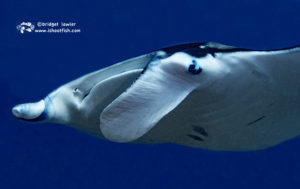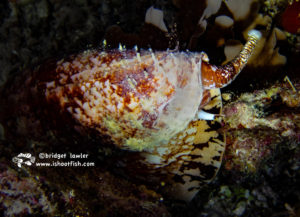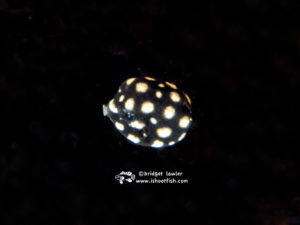^^ This stunningly beautiful fish is a Mandarinfish (Synchiropus splendidus), about 1.5″ long
I recently spent some time in Palau, an archipelago of around 340 tiny islands, situated where the Pacific Ocean collides with the Philippine Sea. Because this sort of thing can create a lot of current, the diving here is fantastic! The Mandarinfish above is just one example of the spectacular life found in this remote place. (I am forever indebted to Sara Clark for finding me and dragging me back to where this little guy was hiding, so I could get this shot!)
We did a couple of manta dives, and I got a few good shots, including this Reef Manta Ray (Mobula alfredi). My camera is not set up for big animals, so they have to get very close to me for the shot to work. In the case of these guys, that made it impossible to get the whole manta inside the frame. The joy, speed, and grace with which these creatures move is always breath-taking to behold, and it never gets old.

But my first love is the tiny things, and oh my, did I have fun with that. In this part of the world, there are multiple species of shrimpgoby, including the gorgeous example below, a Red-Banded Shrimpgoby (Amblyeleotris fasciata). Shrimpgobies live with a shrimp (or two) in the same hole. The shrimp’s job is to continually clear out the sand in the hole, which they do like little bitty adorable snowplows. It is an incredible thing to watch unfold. There are two shrimp living with this goby; the second one is just visible behind the goby’s tail.

The following fish, a Signal Goby (Signiggobius biocellatus) is one of the most beautiful little fish – this was only the second time I’ve seen one. He was tiny, only about 1″ long.

We did Blue Corner, an iconic Palau dive, a couple times. Here the current is ripping, so one must hook into the reef (either a rock or dead coral, nothing alive) with a reef hook, which is a metal hook with a line that attaches to a diver’s BCD. This allows a diver to float above the reef and watch the sharks and large schools of fish hang out, without bashing up the living coral. As natural-born citizens of the wild blue, these guys don’t need reef hooks. This one got close enough I could take a pretty decent shot – it is a Gray Reef Shark (Carcharhinus amblyrhynchos):

The Geography Cone Shell (Conus geographus), below, is considered the most venomous of all cone shells. The long elephant-like nozzle is a feeding tube, and the smaller white tube contains the radula tooth, a harpoon-like weapon that delivers the toxin. We came across this fella during a night dive. This one can be fatal to humans, serving as a great reminder to never touch anything in the ocean!

More pix in the gallery below:
































